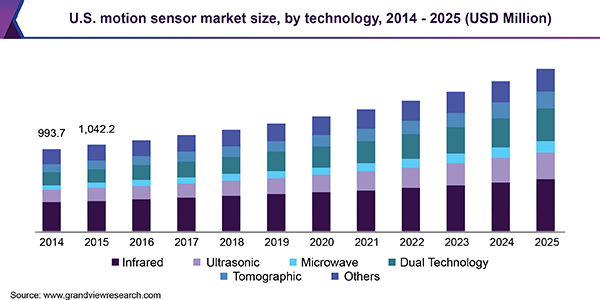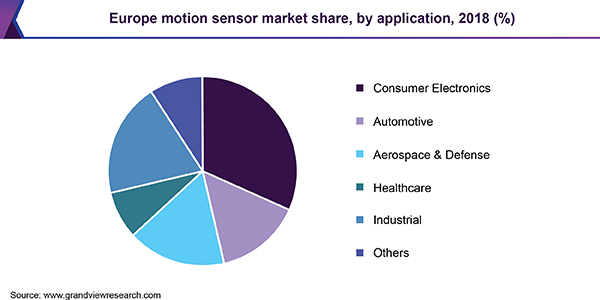The global motion sensor market size is expected to reach USD 8.7 billion by 2025, registering a CAGR of 7.8% from 2019 to 2025, according to a new report by Grand View Research, Inc. Increasing adoption of motion sensors in robotics and gaming applications such as joystick, Augmented Reality (AR) devices, and other gaming accessories have influenced the use of sensing techniques. Significant opportunities in the consumer electronics segment are likely to enhance market growth. For instance, trends in wearable devices have resulted in enormous demand for their variants.
The recent COVID-19 pandemic that has been ravaging numerous countries across the globe has adversely affected the overall sensor, control, and automation industry. While the capital investments in the automation sector have been lethargic before the pandemic, they are expected to be put on hold or postponed for at least a year. However, the recent standstill in industrial manufacturing and production is anticipated to act as a wake-up call for the manufacturing sector on its reliance on human labor. This, in turn, is expected to highlight the advantages of robotics and automation helping a greater adoption in the post-pandemic period. As IoT, industrial automation, and digitalization are expected to become increasingly relevant to post-pandemic Tier 1 manufacturers, it may eventually turn into an opportunity especially in evolving supply chains. The report will account for Covid19 as a key market contributor.
Augmented Reality (AR) and Virtual Reality (VR) are becoming increasingly popular trends in the realm of consumer electronics.AR/VR applications are now a key battleground for smartphones as well as wearable devices such as smart glasses, VR gloves, VR motion chairs, and Head-mounted Displays (HMDs).Motion sensing is a key ingredient in the portable designs built around AR and VR applications. In the past five years, the number of VR users has risen to 150+ million in 2018, from 1 million in 2014. These applications are expected to provide lucrative opportunities to market players. Inertial measurement units (IMU) that use a combination of accelerometer, gyroscope, and magnetometer ensure the stability in environments with high movement fluctuations often encountered in HMDs and AR applications such as smart glasses. Increasing demand for IMUs is expected to drive the market over the forecast period.
Download Free Sample Report @
https://www.grandviewresearch.com/industry-analysis/motion-sensors-market/request/rs1

Some of the key players in the market are HILLCREST LABS; Honeywell International Inc.; Kionix, Inc.; Murata Manufacturing Co., Ltd.; NXP Semiconductors; Robert Bosch GmbH; SENSINOVA; STMicroelectronics; TE Connectivity Ltd.; and TDK Corporation.
Further key findings from the report suggest:
- Growing emphasis of leading technology companies on increasing awareness regarding these sensors in Asia Pacific is a key trend. Intel Corporation recently exhibited advanced applications of motion sensors at the CES Asia – a trade fair organized by Consumer Technology Association (CTA)
- The microwave segment is expected to grow significantly in the next few years owing to their ability to operate in the K-band frequency range, which makes them resistant to interference from external radar sources
- The healthcare segment is expected to gain traction as a result of growing demand for wireless body area networks and smart pill boxes that incorporate motion sensors
- Asia Pacific is expected grow significantly over the forecast period owing to increasing product adoption for detection and prediction of earthquakes and tsunamis in countries such as Indonesia and Japan
- Key players in the motion sensor market are HILLCREST LABS; Honeywell International Inc.; Kionix, Inc.; Murata Manufacturing Co., Ltd.; NXP Semiconductors; Robert Bosch GmbH; SENSINOVA; STMicroelectronics; TE Connectivity Ltd.; and TDK Corporation.
Under the AR/VR domain, these sensors are widely used in gaming applications. A motion gaming system, also called a motion-controlled gaming system, is one that allows players to interact with the system through body movements. In recent years, there has been a significant rise in demand for interactive video games. Growing demand for interactive games can be attributed to rise in penetration of smartphones and wearables, which provides a lucrative opportunity to manufacturers in the consumer electronics end-use industry.
Have some specific queries about this report, our team of analyst will be glad to help!
The extensive use of Micro-electro-mechanical Systems (MEMS) technology has resulted in miniaturization of motion sensors and this bodes well for the market. Increasing adoption of MEMS-based motion sensors can be attributed to need for detection and prediction of natural calamities such as tsunamis, earthquakes, and volcanic eruptions. For instance, the State of California has deployed an earthquake early warning system that uses motion sensors installed across the state for the detection of earthquakes. In addition, the widespread usage of motion sensors in noise, vibration, and harshness indicators as well as step and distance counters for smartwatches has increased product demand.
The market is in its nascent stage and over the coming years it is anticipated to replace manually controlled devices to a large extent. For instance, battery-operated remote controls are now being replaced by gestures and movements without any physical need for devices. In 2018, Intel Corporation developed an advanced form of motion sensing technology that enables TVs to adjust volume and change channels as per a user’s gestures. The major interests of manufacturers vests in driving the demand for advanced generation of processors and semiconductors through innovation.
One of the major factors driving the market is rise in the number of regulations and standards of lighting implemented by various public safety agencies with a focus on reducing electricity consumption for lights. For instance, the American Society of Heating, Refrigerating and Air-Conditioning Engineers (ASHRAE) and the International Code Council have developed the 90.1-10 and International Energy Conservation Code (IECC) energy codes respectively, for new or renovated buildings to minimize energy consumption. In U.S., the International Energy Conservation Code (IECC 2012) mandates the use of motion sensors in classrooms, conference rooms, break rooms, private offices, restrooms, storage rooms, janitorial closets, and all spaces 300 sq. ft. or less. These standards are driving the demand for motion sensors.

Check out special pricing options for sectional purchase and startup companies
Grand View Research has segmented the global motion sensor market based on technology, application:
Motion Sensor Technology Outlook (Volume, Thousand Units; Revenue, USD Million, 2014 - 2025)
- Infrared
- Ultrasonic
- Microwave
- Dual Technology
- Tomographic
- Others
Motion Sensor Application Outlook (Volume, Thousand Units; Revenue, USD Million, 2014 - 2025)
- Consumer Electronics
- Automotive
- Aerospace & Defense
- Healthcare
- Industrial
- Others
About Grand View Research
Grand View Research, Inc. is a U.S. based market research and consulting company, registered in the State of California and headquartered in San Francisco. The company provides syndicated research reports, customized research reports, and consulting services. To help clients make informed business decisions, we offer market intelligence studies ensuring relevant and fact-based research across a range of industries, from technology to chemicals, materials and healthcare.
Media Contact
Company Name: Grand View Research, Inc.
Contact Person: Sherry James, Corporate Sales Specialist - U.S.A.
Email:Send Email
Phone: 1-415-349-0058, Toll Free: 1-888-202-9519
Address:201, Spear Street, 1100
City: San Francisco
State: California
Country: United States
Website: https://www.grandviewresearch.com/industry-analysis/motion-sensors-market

